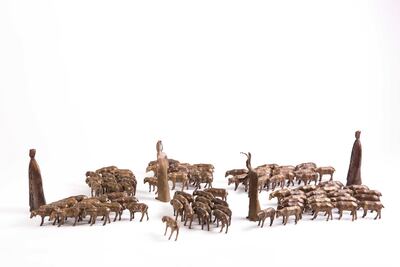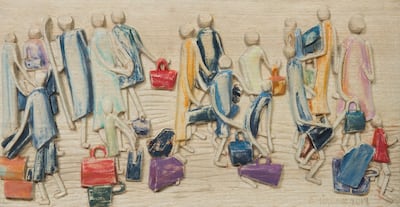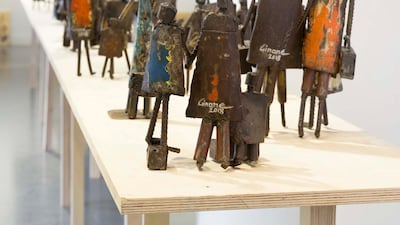In 1983, Lebanese artist Ginane Makki Bacho, now 71, used fragments of shrapnel from bombs that had fallen on her home and studio in Beirut to create sculptures of jagged figures. Off-kilter, sagging, as though weighted down by sadness, their edges were sharp and raw, made from metal torn apart by fire. Entitled Exodus, the series captured the plight of refugees. A year later, Bacho would become a refugee herself, taking her four sons and fleeing the chaos and violence of the Lebanese Civil War for the United States, where she would remain for 16 years.
More than 35 years on, her latest series, Interminable Cycles of Migration, echoes those tragic early sculptures. This time, it is not her own experience of conflict, displacement and life as a refugee that the artist is seeking to capture, but those of the millions of Syrians who have been displaced by eight years of civil war.

The works, currently on show at Agial Art Gallery in Beirut, are the culminating chapter in an enormously ambitious series that has preoccupied the artist for the past five years. "When I decided to come back to Lebanon from America after 16 years there, I decided I wouldn't speak about politics or religion – but we are immersed in it," says Bacho. The veteran artist has experimented with different mediums and styles throughout her career, constantly seeking innovative ways to explore themes that reflect a life shaped by conflict.
Using scrap metals to tell the history of Syria
Her work capturing the suffering in Syria began by chance in 2014, when she began to weld a toy truck for her grandson, using pieces of scrap metal in her studio. When she added part of an old bike chain, the truck began to resemble a tank. Bacho was reminded of the media coverage showing convoys of Isis fighters waving guns and black flags. Instead of giving the truck to her grandson, she welded two gunmen to place inside it. By January 2017, when her solo exhibition Civilisation opened in the Lebanese capital, Bacho had created a vast army, comprising almost 200 sculptures in steel and bronze.
“When I was a kid and I learnt history and there were many invasions – the Crusaders, the Mongols – everything was, in our minds, abstract. We didn’t see anything tangible. I wanted the viewer to see the real history of these last years, the shame to humanity and what is happening to us,” she recalls. “I used scrap metal because of the scrap times we are living in. I think everything is disintegrating – the principles and ideals that we had, the hope that we had, our expectations.”

Sculptures of Isis fighters, smashing priceless artefacts with sledgehammers and brandishing guns atop miniature motorbikes and tanks, were accompanied by prisoners in cages, bodies swinging from gallows and boats laden down with fleeing figures. In Interminable Seasons of Migration, Bacho focuses on the refugees, reminding viewers that although Isis has been overthrown, its brutal reign – and the wider conflict in Syria – has left millions traumatised and homeless. "During my previous show, some people asked, 'Why do you want to remind us of the cages and the slaughter?'" she says. "I said, 'It's what happening. I'm not making it up.'"
Isis may be the perpetrators, but are we all complicit?
A long, curved wooden table serves as a walkway for Bacho's figures. Small groups of men, women and children straggle from one end to the other, all moving in the same direction. Some carry tiny babies strapped to their backs in metal slings. The artist has meticulously arranged each figure in a pose suggesting movement, giving them a precarious, lopsided feel. They cling to one another but also to the bags, boxes and suitcases containing their worldly possessions. Scattered among them, a few children walk alone, separated from loved ones. Abandoned luggage is strewn along the route.

Bacho poured emotion into each figure, reminded of her own wartime experiences and the need to be ready for instant flight. “I remember most of the time my husband would take off his shoes as soon as he came home from work, whereas during the war, I was always in a jumpsuit and tennis shoes, because I had babies,” the artist recalls. “I was ready any time, but twice my husband left without shoes. So it happened to us.”
The scrap metal she uses is often salvaged from old cars, leaving some figures covered with a patina of colour that has been stained and blistered by the welding process. “I’m excited to see what the fire gives me. It’s interesting because sometimes silver becomes gold or white. It’s never a plain colour,” she says. The result is a procession marked by rust and flame, as though the figures have literally walked through hell in search of safety.
A second group of cast bronze sculptures are more figurative, with soft, rounded, polished surfaces and elongated necks, giving them a vulnerable feel at odds with the jagged, fire-scarred strength of the scrap metal figures. A series of hand-carved wooden reliefs capture refugees carrying their luggage and children across a textured surface of gently undulating lines that might represent earth or water.
Bacho's exhibition is a made up of powerful pieces of political commentary
The final procession in the exhibition is the most powerful piece of political commentary. Using a mould, Bacho has created more than 50 identical bronze sheep. Walking with hanging heads, they form a narrow column, herded by robed human figures with deep-set, skull-like features. One has a whip raised above his head, ready to strike. The figures represent religious and political leaders, the artist explains, while the sheep represent the global masses, who continue to accept leaders that incite violence and ignore human suffering.
“Now I feel like I’m done. I finished my story,” she says, reflecting on the five years of work that have led to this final damning symbol. “The conclusion was about the people. Why is all this happening? Because of the people who are accepting to be victims of their politicians who are corrupt, who are accumulating money while we have nothing, and of religious figures.”
There is anger and pain in Bacho's work. It conveys a lifetime of suffering and disappointment and blame, an obsessive struggle to reflect the evils of the world in the hope that people will not continue to look away. But there is also hope. Lost amid the sea of sheep, a single animal is facing backwards, moving against the herd. The artist silently begs her audience to look closely enough to find that single sheep – and to understand its significance.
Interminable Seasons of Migration continues at Agial Art Gallery in Beirut until August 31

